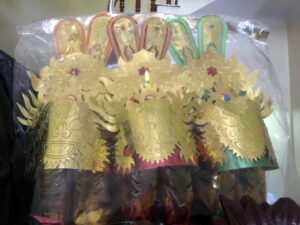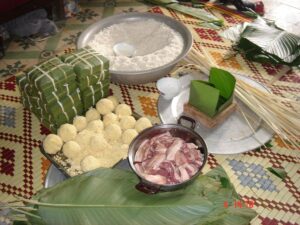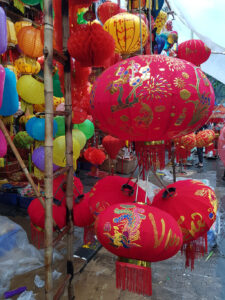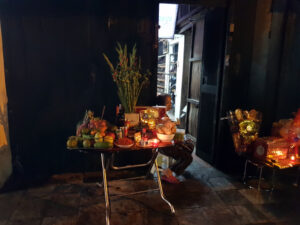Although Vietnam is a multi-ethnic country with many varied cultures and practices in each area, all ethnic groups in Vietnam have one holiday to celebrate together – the Lunar New Year. Also known as Tết, the holiday is a much loved a festival that the whole nation excitedly welcomes.
Unlike the New Year Celebrations in Western nations, the Lunar New Year in Vietnam is more akin to Christmas. It is a time for gifts and feasts, for family reunions and blessings for the coming year. Most businesses and official offices will close down for the period while transport and accommodation services are often booked months in advance. Unless you are staying with a family, Tet can can be a difficult time to travel for visitors and locals alike.
Lunar Calendar
The Lunar New Year festival is celebrated in most countries of the East Asian Cultural Area, which includes China, Japan, Korea, and Vietnam. Tết holiday is short for Tết Nguyên Đán or Tết Cổ Truyền which translates as ”the original feast of the first morning” (Feast of the first morning).
Every year, Tet is held on the first day of the first lunar month but there are many rites and customs to fulfill prior to and after this pivotal day. Traditionally and officially, the Lunar New Year holiday typically lasts around two weeks. From the 23rd of the twelfth month to the 8th of the first month of the lunar calendar.
As mentioned, Tet is the transition period between the old and new lunar years and has many side as well as a myriad of rituals with spiritual and cultural connotations. According to the Eastern conception, this is a time when heaven and earth are reconciled and mankind is reconnected to the gods. It is also the most auspicious time for the ancient gods to hear and bless people’s petitions.
Origins
There are many arguments surrounding the origins of this holiday but most will assert that the Lunar New Year was an occasion for farmers to pay respects to the “weather” gods, such as Earth god, Rain god, Water god, Sun god, and so on. Signalling the end of winter, it is a time to give reconcile the events of the past year and to pray for a future of favorable rain and sun to speed a bountiful spring harvest.
Likewise, this is also an occasion for individuals in families to reestablish their emotional and spiritual bonds with their loved ones in order to feel more attached, at rest, and happy. Furthermore, it is regarded as a “soothing” period, a time to leave any bad luck or sorrow from the previous year behind days and look forward to a happy, successful and peaceful year ahead.
The Ông Táo
According to Vietnamese tradition, the 23rd day of the last Lunar month (a week before Lunar New Year) is dedicated to the Ông Táo. The Ông Táo is loosely translated to Kitchen or Stove Gods and are important to the safety and prosperity of the family home.
It is the time these lesser gods ascend to heaven to report to the Jade Emperor (the supreme Lord of Heaven) on the happenings in the host’s household during the previous year . On this day, people furiously clean their residences and prepare a dish of rice as nourishment for the Kitchen Gods to take with them for their trip to heaven. Special “votive” objects such as hats, boots, and robes are made from paper and ritually burnt, so the gods are suitably attired for their audience with the supreme god. Often fishes will be placed into a basin of water before being released into a river to provide transport for the Kitchen Gods’ ride to paradise.
Preparing for the Tet holiday, everyone will be busy cleaning, purchasing, and tastefully decorating their house. A literal “spring clean”, to both ensure a favorable Kitchen god’s report but also getting the house ready for the guests and distant family who will visit later in this very social calendar.
The Trees of Tet
In Christian countries, the humble fir tree has become a symbol of Christmas. Despite growing in a hard and cold climate, the firt remains vigorous and perennially green even in the dead of winter. As such, it can be seen as a sign of luck, happiness and perseverance and is decked with ornaments at Christmas season. Similarly, during Tet the Vietnamese will adorn their homes with flowers, trees and other plants as symbols of growth, fertility and beauty
Most people in the North of Vietnam will prefer peach, kumquat and other citrus trees to decorate for the event, not only because they are suited to the region, but also cause they have a unique meaning. According to feng shui, the Peach tree represents a full confluence of the five elements and will chase away evil spirits while sowing hope and faith for a joyful and prosperous new year.
A kumquat tree, with its green branches and leaves, lush with luscious yellow fruits, and scented flower buds is another favourite. A warning however is not to eat the fruit from these special ornamental bushes during Tet as they have been chemically treated to produce the uniform color and ripeness needed.
Not only bringing favorable omens, the Kumquat tree also creates a serene environment and provides a symbol of abundance and prosperity for the coming year. But the selection is various and many Vietnamese now opt to adorn mandarin trees, orchids, pomelo trees, and so on for this festival. However, these the peach and kumquat trees remain the most ubiquitous Tet emblems.
Banh Chung
“Banh Chung” roughly translates as “Distilled Cake” as it is made by boiling, not baking. The wrapping and process of making the famous Chung Cake is an ancient custom and a special part of the Tet preparations. The practice began during the time of King Hung (2879-258BC), the legendary dynasty of Vietnamese pre-history and symbolizes thankfulness to ancestors and the Gods of heaven and earth.
As well as Tet, Banh Chung will also be prepared for the anniversaries of the Hung Kings (one of Vietnam’s largest events celebrated on the 10th day of the third lunar month). Its ingredients include glutinous rice, mung bean, black pepper, fatty pork, salt, and shallots. Fish sauce is sometimes used to enhance the taste.
The square-shaped cake is then wrapped in leaves and an outer layer of Lá Dong (Stachyphrynium Placentarium) is wrapped with strings made from Giang– a species of bamboo with a particularly long shoot. Depending on the region, the wrapper can also be made with banana leaves or other large fragrant leaves before being continually boiled in a saucepan for 8-12 hours prior to being removed and allowed to cool.
A Long Process
Banh Chung will remain preserved outdoors for 3-5 days, depending on temperature and weather. Many Vietnamese will fondly remember the ritual where, along with the chilly weather and the drizzle fluttering over the peach flowers, the oldest members of the family put the final touches to the Banh Chung, teaching the younger members around them how best to wrap the processes squares into gorgeous and exquisite table offerings.
The yellow hue of mung bean tinged rice cake and the vivid green of the leaf wrapping symbolizes a cozy and serene existence where individuals seek to create a relation not only between generations in the family but also to bring the family together. It is said that only family members can feel “the bright warm wire” in their spirit because of this pure natural connection.
Feasts and Prayers
Aside from preparing specialist cuisine such as Banh Chung, Vietnamese will need to prepare needed utensils and food before welcoming the New Year. This is for the very practical reason that many shops, marketplaces, and supermarkets will be closed during Tet. There is also the belief that whatever the family lacks on New Year’s Day, the luck for the entire year following will be a lack of the same. .
As a result, people will purchase food in over abundance, as well as candy, snacks and drinks for youngsters and to welcome visitors. As a result, the price of staples on the days before Tet rise dramatically.
Đạo Hiếu or filial piety is a fundamental concept of religion in Vietnam. No matter what religion people practice, Đạo Hiếu is regarded as a barometer of a Vietnamese person’s moral standards. This is mirrored in the practice of ancestor worship, with grandparents and each family having an ancestral shrine to keep the family religion alive in the home. It is a common belief that once an individual dies, they have a” ghost-mind” that lives in the third realm and always watches over and protects their living descendants.
The Revered Ancestors
As Tet draws near, family members will visit the graves of their ancestors to clean and beautify them while burning incense to invite the ancestors’ spirits to return and join with their family in celebration of the New Year. Alternatively, they will bring presents to Nhà Thờ Họ ( the clan’s ancestral house – the traditional site of worship of the Vietnamese clan or the branches formed by the family’s descendants), to burn incense to pay homage to the family’s revered ancestors.
Along with visiting ancestors’ graves on Tet preparation days, the Vietnamese also have the essential ritual of placing the Five Fruits dish on the altar on New Year’s Day. The Five Fruit Tray is thought to have originated from the Yulanpen Sutra lexicon, which is a Mahayana sutra about filial piety. It is made out of 5 various colored fruits, namely green, yellow, red, orange and white, that represent the “Five Strengths” in Buddhism – faith, energy, mindfulness, concentration, and wisdom.
According to feng shui, this set of five components represents full and fortunate energy so the placement of the five-fruit tray on the altar not only demonstrates filial respect to the ancestors but also conveys the hope that the family will be healthy and peaceful in the next year. Even in these modern times, the “legacy” is still passed down from generation to generation as an essential part of the Tet celebrations.
The Stages of Tet
Tết is split into three periods: Tất Niên (the period prior to New Year’s Eve), Giao Thừa (New Year’s Eve), and Tân Niên (celebration of the New Year). The final day of Tết is the 12th day of the first lunar month and the final day of Tất Niên. Each family will gather and prepare a feast with traditional foods as altar offerings to thank their ancestors for attending the preceding celebrations.
Especially indispensable is the votive offerings, the burning of incense and “dedication texts” from the family bloodline to honor the generations who came before and taught them how to achieve prosperity. Of course, Giao Thừa (New Year’s Eve itself) marks the transition from the old to the New Year. This is regarded as a most significant moment, a time when yin and yang combine, heaven and earth harmonize, all things flourish and humans are near to the gods. It is also a time when most gods will listen to their descendants’ petitions.
A Family Affair
During this Giao Thừa, all members of a family will assist in making food offerings, not only for the family altar but also to place outside. A ceremony tray decorated with votive paper, incense, lamps, oil. food and other items and often placed near the entrance of homes. This is to show respect and farewell to the Kitchen Gods who ruled the family in the previous year and in welcome to the new gods who will take charge of their home in the New Year.
According to the lunar calendar, the hour of greatest significance is midnight. Every morning for the next three days after Giao Thừa, all adult members of the family are expected to wake up early to perform rituals such as preparing meals and burning incense to bring to the ancestral shrine. The “rice tray” will now include full boiled chicken, Banh Chung, pickled onions, Spring rolls, and other delicacies. On the final day, votive paper is burnt as a last ”goodbye” to their ancestors’ spirits and a final chance to ask for blessings before they return to the afterlife for another year.
Xong Dat
Vietnamese people also visit family or friends throughout the first three days of the New Year to wish them a happy new year (Chuc Mung Nam Moi) and a prosperous future. In Vietnamese custom, the first visitor a family welcomes into their homes during the New Year will decide the family’s fortunes. So people will not enter a house at Tet unless they are invited first – this custom is known as Xong Dat and the first guest will be chosen based on their age according to the lunar year and the match with the owner on matters such as age, personality and success. A successful Xong Dat brings luck and good fortune to the homeowner.
Chuc Mung Nam Moi
Good luck and wishes are codified in such phrases as “Sống lâu trăm tuổi”: (Live long and prosper for a hundred years!): a phrase used by youngsters to refer to their elders. “An Khang Thịnh Vượng“: (security, good health, and prosperity); ”Năm Mới Thắng Lợi Mới’‘: (New year, new successes!; frequently used in political speeches) or ”Năm Mới Toàn Gia Bình An” : (I hope the new year brings you health and peace!). Similar to the Western cry of “Happy New Year”, these phrases are used to signal good intentions to others and the hope for a fresh and better future.
Every positive event that happens on the first day of the New Year is said to be full of blessings and luck for the rest of the year. One of the taboos on the first day of the lunar year is cleaning the home because it represents wiping away luck, fortune. For a family who have lost a loved one in the preceding year, it is generally not acceptable to proactively visit friends and relatives during the Tet holiday as this may be unlucky for the owner.
Mừng Tuổi
Like their counterparts at Christmas, Vietnamese children look eagerly forward to the Tết festival not least because of the “Mừng Tuổi” . On the first day of the year, children in the family receive red envelopes containing money from their elders or adult relatives, their parent’s friends and anyone else who wishes to curry favor with the family. These small packets are known as “Lucky Money” and come with best wishes for a New Year, good health, rapid growth, and academic achievement.
There is a known “joke” with this tradition to be wary of parents who collect the kid’s Lucky Money for “safe keeping” but never seemingly able to find the same when it is asked back!.
Temple Visits
Another strong tradition for Vietnamese during Tết is a visit to at least one pagoda or temple. Beginning around New Year’s Eve, people frequently make pilgrimages to nearby pagodas and sacred temples to pray for luck and tranquility for their families.
However, the visits are often not only for religious reasons but also to explore the richness of their country and enjoy an outing with family and friends. Here in Ninh Binh, Thiên Tôn pagoda and the Bái Đính pagoda are popular with families while single, young people will favor the more romantic pagodas like Duyên Ninh and Am Tien, to pray for future love and successful relationships and perhaps to meet people with similar desires.
In Ninh Binh, Tết marks the beginning of the end of winter and the coming of the spring season. Farmers will start preparing their fields for the coming planting season and all will look forward to the time when the plants are flourishing, the birds are returning to the nest and the cycle of life begins again. It signifies a time of hope, symbolizing a positive future, looking forward for the good things to come and leaving the things behind that are detrimental to your heart.
While there is no such thing as flawless perfection in this world, Vietnamese will always lean towards the positive, leaving behind unpleasant memories to embrace a new “milestone” in their life. Tết is the Vietnamese people’s “good time milestone”, a moment to remember the good times, celebrate the new and discard past failures. So a big Chuc Mung Nam Moi from all of us here at Discover Ninh Binh!









